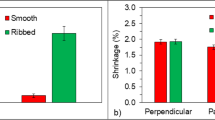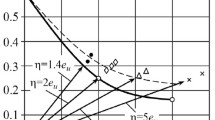The deformation behavior of porcelain and half-porcelain samples during calcination with different type of loads—bending, tension, and torsion—is investigated. The temperature dependences of the effective viscosity of the materials are calculated. The simplest method of determining the deformation stability is bending cantilevered samples, and the most informative and accurate method is torsion of thin-wall tubes.
Similar content being viewed by others
References
N. V. Solomin, High-Temperature Stability of Building Materials and Structural Components [in Russian], Mashinostroenie, Moscow (1980).
V. S. Bakunov, A. V. Belyakov, E. S. Lukin, and U. Sh. Shayakhmetov, Oxide Ceramic: Sintering and Creep [in Russian], Izd. RKhTU im. D. I. Mendeleeva, Moscow (2007).
T. A. Romanova, E. A. Shilova, and O. A. Nosova, “Methods for evaluating the tendency of porcelain pastes to deform during calcination,” in: Collection of Scientific Works on the Investigation of Ceramic Raw Material and Perfecting the Technological Processes Used in the Production of Porcelain Articles [in Russian], TsNIITÉILETPROM, Moscow (1990), pp. 156–163.
J. M. Gaillard, C. Gault, J. C. Glandus, and P. Petrault, “Prediction of tableware deformations using a finite elements analysis and the measurements of physical parameters of process conditions,” in: Ceramic Today — Tomorrow’s Ceramics (1991), pp. 333–341.
T. Kraft, H. Riedel, F. Raether, and F. Becker, “Simulation des Brennprozesses bei der Herstellung von Gebrauchskeramiken,” Keram. Zeitschrift, 54, 374–381 (2002).
A. P. Pyzhova, V. V. Korobkina, and V. S. Kosov, Defects of Thin-Wall Articles: Reasons for the Appearance and Methods of Elimination [in Russian], Legprombytizdat, Moscow (1993).
T. Kraft and H. Riedel, “Numerical simulation of solid state sintering — model and application,” J. Eur. Ceram. Soc., 24, 345–361 (2004).
V.-P. P. Yakushka, Particularities of Creep of Ceramics and Refractory Materials under Different Types of Loads, Author’s Abstract of Candidate’s Thesis [in Russian], Kaunas (1983).
D. V. Andreev, A. I. Zakharov, and O. M. Kolesnikova, “Cantilever sample investigation of the deformation behavior of porcelain during calcination,” in: Collection of Scientific Works on Progress in Chemistry and Chemical Technology [in Russian], Izd. RKhTU im. D. I. Mendeleeva, Moscow (2008), Vol. 22, No. 7, pp. 47–49.
Author information
Authors and Affiliations
Additional information
Translated from Steklo i Keramika, No. 1, pp. 10–12, January, 2009.
Rights and permissions
About this article
Cite this article
Andreev, D.V., Zakharov, A.I. Deformation of porcelain articles. Glass Ceram 66, 8–10 (2009). https://doi.org/10.1007/s10717-009-9110-1
Published:
Issue Date:
DOI: https://doi.org/10.1007/s10717-009-9110-1




